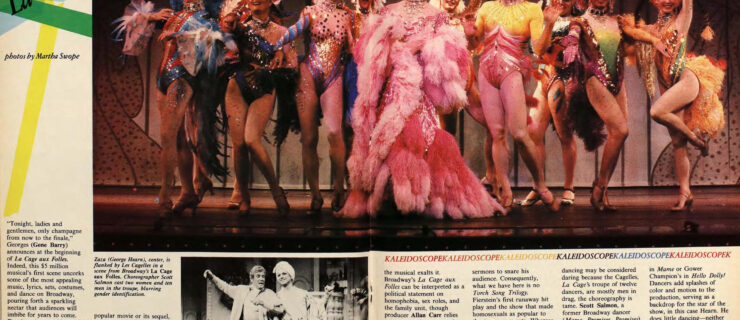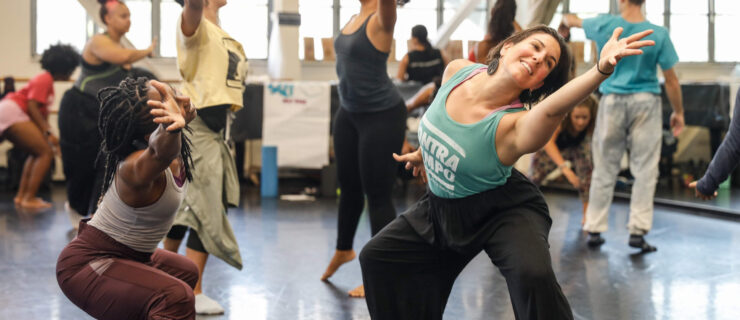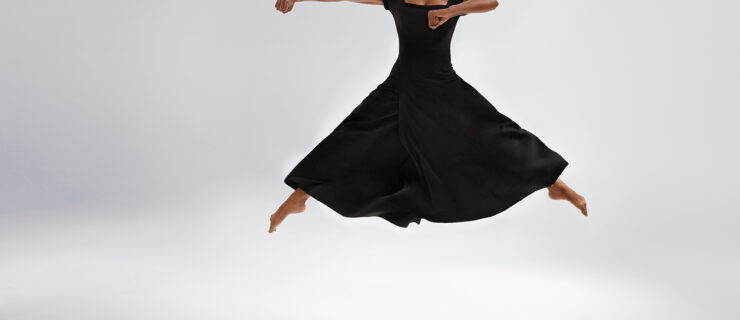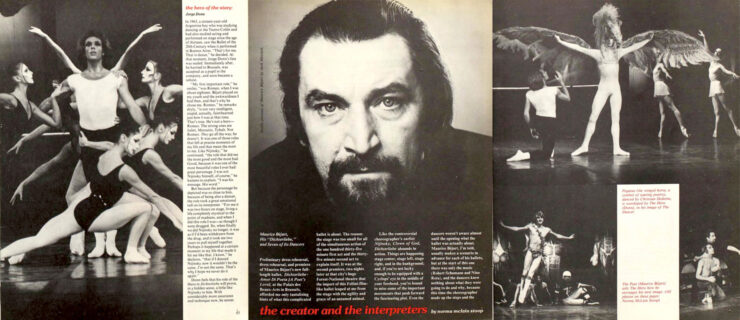The Magic Pilgrim
In the dying light of a summer’s day, an Asian woman, her hair in a pigtail, turns slowly in the weeds by a Brooklyn canal. One hand is at her chest, the other stretches out to the side. Behind her, across the canal, is a factory, its windows catching the reflection of the setting sun. Near her, six other dancers turn, glide, and leap in and out of an aluminum cube frame with seven-foot sides. Seven trombonists play. It’s terrifically hot, and the performers shift their locations. From time to time, they enter a silo-shaped building where there’s air conditioning, black-and-white film, and a few wandering audience members. One performer dances intermittently on a grate above the silo’s staircase. Called Sundown, the work, in its entirety, is seven continuous hours, performed by these seven dancers and seven musicians. The mysterious woman by the water’s edge is its choreographer, Yoshiko Chuma.
Chuma is a maverick, utterly unique, a “one-off,” as the British say, on the stage of world dance. Her career has spanned almost 30 years and 35 countries. Her work is a mixture of play and seriousness, anarchy and reflection, and her hallmarks are collaboration and cultural exchange. Chuma cuts across categories. One might call her a postmodern choreographer, a movement designer, or a visual artist whose primary medium is human beings—dancers, musicians, pedestrians. She is unusually alive to space and landscape, indoors or outdoors. Gifted with great personal force and intelligence, at heart she is an experimentalist, a fierce explorer with a profound sense of structure.
Her company is called Yoshiko Chuma & The School of Hard Knocks, named in 1980 when Chuma was still new to this country and intrigued by American idioms. A thousand dancers have appeared with her over the years. Early on, the work was large and antic: Five Car Pile-Up featured a hundred performers armed with newspapers, trench coats, and folding chairs; it was high energy and what some have called “choreographed chaos.” Her work was anarchical: Without permit, her dancers performed in the subways. A whiz at site-specific work, Chuma was the first choreographer to require the dancers of the GROP, the Paris Opéra Ballet’s fine modern dance unit, to perform outdoors, at the foot of the Eiffel Tower. Her work is often community-based, where everyone is a collaborator, as in her 1993 commission to stage the opening of New York City’s vast and giddy Halloween parade. For GAME/PLAY at New York’s Asia Society in 2004, she gathered performers from several countries to recount stories about the games of their childhoods. Chuma shaped those tales and games into a charming and universal theatrical work.
Some of her work is smaller in scale and more intimate. For Solos With a Phonograph in 2001, she walked up to an old phonograph, put on one of her old 78s, and performed a haunting solo. One at a time, several other dance artists chose a record and danced their own solos. In “The Living Room Project” (1997-99), with versions done from New York and Allentown, Pennsylvania, to Tokyo and Budapest, dancers and musicians performed in the living rooms of selected hosts and their invited guests.
Chuma herself—still a powerful and compelling performer at 56—usually dances in her work and has performed solos at Judson Memorial Church during their New Year’s Eve poetry readings. In white tails, she danced in the spring rain with double bassist Robert Black as part of the Lincoln Center Out of Doors festival.
In addition to longtime collaborators like Black and visual artist Ralph Lee (she has been working with his aluminum cubes since 1999), young choreographers and dancers are eager to work with her. Her company has included talents as diverse as Sasha Waltz, now an internationally sought-after dance artist living in Germany, and downtown powerhouses like the British choreographer Sarah Michelson and Americans Vicky Shick, Dan Froot, and Christopher Williams. Chuma choreographed and directed Tan Dun’s opera, Nine Songs, long before he scored Crouching Tiger, Hidden Dragon.
“Fate and chance,” she says, are what have been responsible for her remarkable career. As a young woman who had been active in political protests in her native Japan, Chuma came to America 30 years ago. She quickly settled in downtown Manhattan and found herself in the milieu of theater experimentalists Ellen Stewart, Robert Wilson, and Mabou Mines, and dance avant-gardists Steve Paxton, Simone Forti, Meredith Monk, and Pooh Kaye. She picked up on the creative vibe of downtown New York at that time. “It was so exciting just watching people on the street,” she recalls of her beginnings. “It’s a dance.”
In 1977, a year after her arrival in the U.S., she first appeared in Douglas Dunn’s Celesta, and was influenced by minimalism and the loft and downtown scenes as well as the landmark Einstein on the Beach by Robert Wilson and Philip Glass. From Japan she already had a passionate and innate sense of politics. She met poet Allen Ginsberg and performance artist Eric Bogosian. She took Ginsberg’s philosophy of “First thought, best thought” and applied it to dance making. She came to know Edwin Denby, the dean of American dance critics, in 1978 and later married Jacob Burckhardt, son of the filmmaker and photographer Rudy Burckhardt, Denby’s closest friend. Her husband often creates the soundscapes, videos and films that accompany her work. (Their teenage son Hugh sometimes travels with her and works on her productions.)
She gives credit to Pooh Kaye, who, in their early years of sharing a loft, collaborated with her on projects that were outlandish, arduous, and inspired. Chuma started using chairs and props in work that was—and still is—deeply structured in concept. There were other artists she worked with and who influenced her, including painter Alex Katz and composer Alvin Curran. “I have to accept somewhere that I’m very disconnected, with different histories,” she remarks about her eclecticism.
As if this weren’t enough, Chuma also directed, in addition to The School of Hard Knocks, Ireland’s Daghdha Dance Company, commuting between New York and Limerick for four years, beginning in 2000. Her Yellow Room for that company, performed within a yellow room constructed onstage, toured Ireland in 2003. “Exciting, bright, skillful” is how she describes the dancers, musicians, and composers of Daghdha.
Her upcoming work, A Page Out of Order, receives its U.S. premiere mid-January at Dance Theater Workshop. It was inspired by a Japanese silent film of the 1920s, A Page of Madness. In Chuma’s work, singer Sizzle Ohtake portrays a benshi, a narrator who accompanied silent films in Japan. The work will use dancers from the U. S., Japan, and Macedonia (where she has worked extensively), as well as Macedonian music and a shakahachi player from Japan. The mix is typical of her highly successful cultural fusion.
Choreographer/performer Dan Froot, his work and life strongly influenced by Chuma, recalls working with her. “You never know what will make Yoshiko laugh,” he says. “Her abundant humor seems driven by the non sequitur. Part of her ability to see absurdity and irony in everyday life is her position as a cultural outsider. But probably a bigger part is just Yoshiko; her irrepressible cackle transcends all that cultural outsider stuff.”
Chuma has an inquiring mind about art, music, dance—and myriad aspects of the world around her. Although she is sure about what she wants in rehearsal, she always keeps open to the next possibility. “What my work is about?” she asks, chuckling. “I do not know.”
Amanda Smith, a longtime contributor to Dance Magazine, is on the faculties of Coe College and Hofstra University.




